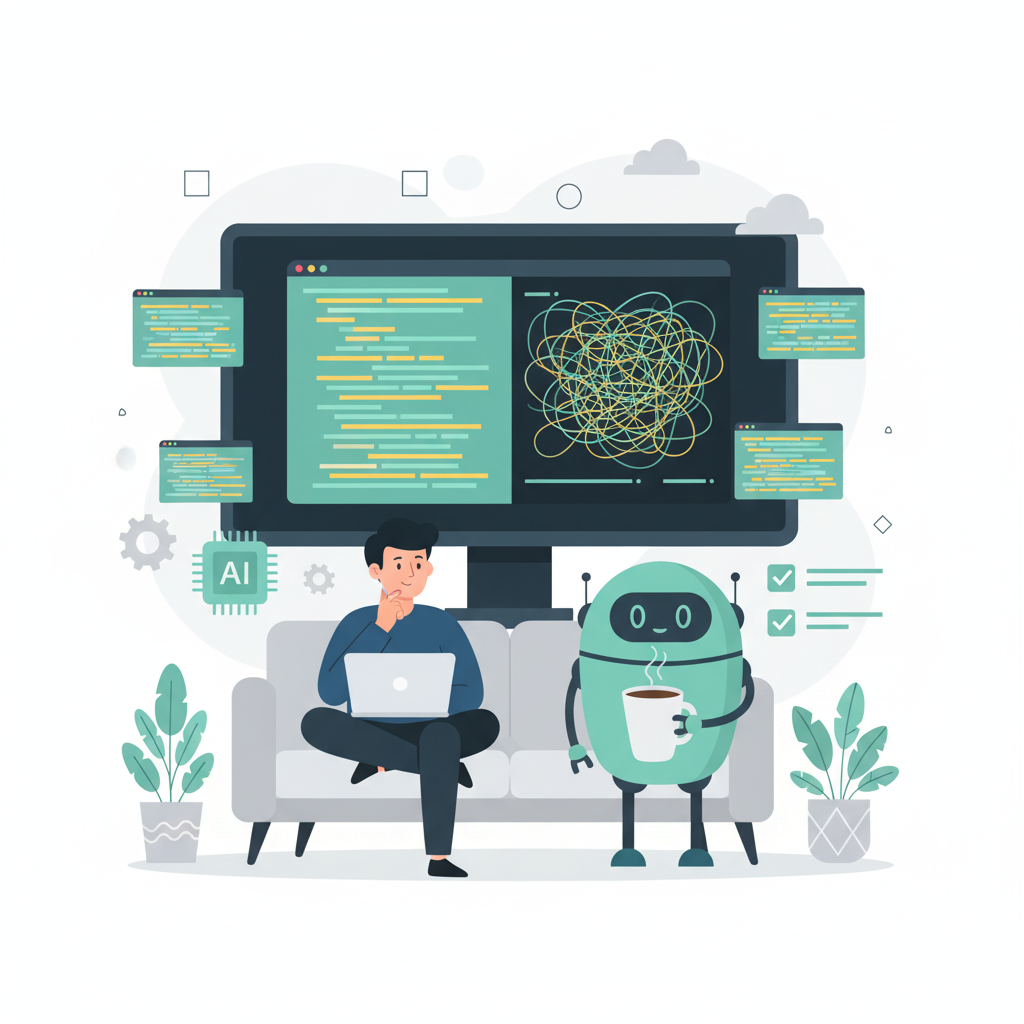AI can write code in seconds. The promise? 10x productivity gains. But there’s a reckoning happening right now across engineering teams worldwide – they’re shipping faster, sure, but they’re also piling up technical debt like never before.
This is more than a technical shift. It’s a cultural transformation that’s happening whether you like it or not. On one end you’ve got vibe coding – rapid, conversational prompts that spit out working code in minutes. On the other end, spec-driven development has emerged as the quality-conscious response. And between them sits the AI slop phenomenon, forcing teams to figure out what “good code” even means anymore.
This guide explores how AI code generation is creating new cultural challenges in engineering teams, examining patterns from vibe coding to AI slop and the emerging governance frameworks that are evolving in response.
If you’re facing this dilemma – how to capture AI’s speed benefits while maintaining code quality and team culture – let’s dig into what’s actually happening and what you should do about it.
What is vibe coding and how does it differ from traditional development?
Vibe coding is what happens when you describe what you want to an AI in natural language and it writes the code for you. Steve Yegge coined the term in mid-2024, though Andrej Karpathy popularised it in early 2025 with this description: “fully giving in to the vibes, embracing exponentials, and forgetting that the code even exists.”
Traditional programming requires you to hold two things in your head at once – high-level intent and low-level implementation details. Vibe coding collapses that into a single layer – you focus on intent, the AI handles implementation.
Where traditional development follows careful planning then implementation, vibe coding inverts this. Generate code immediately, then iterate on it.
The numbers tell the story. 25% of YC startups indicated that more than 95% of their codebase is AI-generated. Google reports over a quarter of new code is AI-generated.
The appeal is obvious – less boilerplate, faster iterations, lower cognitive load. But there’s a catch.
What is “AI slop” and how do I recognise it in my codebase?
AI slop is low-quality AI-generated code that looks like it works but contains hidden flaws, lacks maintainability, or isn’t fully understood by the developers who shipped it.
Here’s what makes it dangerous: it passes basic tests. It looks sophisticated. It might even solve the immediate problem. But it’s fundamentally flawed underneath.
Kin Lane, an API evangelist, put it bluntly: “I don’t think I have ever seen so much technical debt being created in such a short period of time during my 35-year career in technology.”
GitClear’s research confirms this – they’re seeing rising code duplication and declining quality as AI coding tools gain popularity. The data is stark: AI-generated code has a 41% higher churn rate, meaning it gets rewritten or deleted more frequently.
Red flags to watch for:
Overly verbose or unnecessarily complex code. AI often generates way more than you need.
Solutions that don’t align with your existing architecture. AI excels at one-off code but misses the bigger picture because of context window limitations.
Poor error handling or missing edge cases.
Code the submitting engineer struggles to explain. That’s your clearest warning sign right there.
The context window problem is worth understanding. AI can only process 4K to 200K tokens at once. It can’t see your entire codebase. So it generates solutions based on limited context that work in isolation but clash with your broader architecture.
What is spec-driven development with AI and why is it emerging now?
Spec-driven development is the industry’s response to vibe coding’s quality problems. It’s a structured approach where you write detailed specifications before using AI to generate implementation code.
Nikhil Swaminathan and Deepak Singh describe the problem like this: “I’m sure you’ve been there: prompt, prompt, prompt, and you have a working application. It’s fun and feels like magic. But getting it to production requires more.”
That “more” is specifications. Requirements, architectural constraints, test cases, edge case handling – all written before you prompt the AI.
This approach emerged in 2025 as teams who’d been shipping with vibe coding through 2024 hit quality issues and needed something better. Amazon Q and AWS launched Kiro with both Vibe Mode and Spec Mode. GitHub and Anthropic promoted spec-driven approaches.
The realisation? Specifications help AI just as they help humans. Better context produces better code.
It’s a “back to basics” movement. Do proper planning before implementation, but use AI as your implementation partner. You get the speed benefits and the quality.
How does AI code generation change the way engineers think about software development?
The shift is as much psychological as technical. Stack Overflow’s 2024 Developer Survey of over 65,000 developers found 76% are now using or planning to use AI coding assistants. This isn’t a fringe experiment anymore – it’s mainstream.
Engineers are spending more time reading code than writing it. You’re evaluating AI output, verifying it fits your architecture. The skill emphasis shifts from “how do I implement this” to “what should I build and how do I verify it works.”
Prompt engineering becomes a core skill. Knowing how to give the AI good context matters as much as understanding algorithms used to.
The knowledge gap issue is real, particularly for junior engineers. AI lets them ship code they don’t fully understand. This creates “knowledge debt” – technical debt that lives in the engineers’ heads rather than in the codebase.
And code ownership gets complicated. Who’s responsible for code they didn’t write but did prompt into existence? These questions change how teams think about quality and accountability.
How do engineering teams balance speed of AI coding with code quality?
Here’s what the data shows: Teams with strong code review processes experience quality improvements with AI, while those without see quality decline. The technology amplifies your existing practices, both good and bad.
This means your code review process needs specific updates for AI-generated code. Your standard review practices won’t cut it anymore.
Add comprehension tests. Require submitting engineers to explain their code in review. If they can’t walk through how it works, it doesn’t ship. Simple as that.
Establish quality gates. AI can draft quickly but human review must verify alignment with architecture and standards.
Use AI appropriately. Prototyping and boilerplate? Good AI use cases. Novel logic and security-sensitive code? Those need more human control.
Combine approaches. Use vibe coding for exploration, spec-driven for production. Let engineers play with vibe coding to figure out approaches, but require specs for production code.
How does vibe coding affect technical debt accumulation?
Vibe coding creates unique challenges. Those speed benefits? They also accelerate how quickly debt compounds across your codebase.
The compounding effect is where vibe coding gets expensive. One engineer uses AI to generate an authentication flow without specs. A month later, another engineer prompts AI differently for similar functionality. Six months in, you’ve got five different approaches to the same problem scattered across your codebase.
The “it works now” mentality defers proper error handling and maintainability. Initial velocity gains get offset 3-4 months later when teams hit the debt wall. What took 2 hours to generate might take 20 hours to fix later.
Why are some teams moving from vibe coding back to spec-driven approaches?
Quality issues emerged after the initial excitement wore off. Teams found they were shipping bugs faster, not just features faster.
The timeline tells the story. Vibe coding excitement peaked mid-2024. Quality reckoning happened late-2024/early-2025. Spec-driven response emerged in 2025. The pattern echoes Facebook’s move fast legacy – velocity-first approaches create quality problems that take time to surface.
Consider a fintech startup that went hard on vibe coding in mid-2024. Six months later, they had 200,000 lines of AI-generated code and mounting issues. The team spent two months refactoring before they could ship new features again.
Organisations treating AI as a process challenge achieve better outcomes. The teams succeeding with AI changed their development process, not just added a new tool.
The balanced approach? Vibe coding for discovery, spec-driven for delivery.
What does “machine-optimised code” mean for the future of engineering culture?
Machine-optimised code prioritises AI comprehension over human readability. The assumption is that AI might be the primary reader of code in the future.
This challenges a long-held value in software development – code as communication between developers. If AI is reading and writing most code, does that still matter?
Humans still need to debug and understand code. But the question is getting asked, and that’s significant.
Senior engineers who value readable code are in tension with new engineers who trust AI to handle complexity. That’s a cultural divide playing out right now in teams everywhere.
Your engineering culture will transform. The question is whether you’re actively shaping that transformation or passively reacting to it.
Is vibe coding making our codebase worse over time?
It depends on how you’re using it. Vibe coding without quality controls? Absolutely, it accumulates technical debt. Use it for prototyping and exploration, but require spec-driven approaches for production code. Establish clear guidelines for when each approach is appropriate.
How can teams prevent AI slop from entering the codebase?
Require engineers to explain their AI-generated code in review sessions. If they struggle, the code needs revision. End of story.
Adopt spec-driven development for production code. Train your team on effective prompt engineering. Monitor code quality metrics for AI-assisted work.
Most importantly, create a culture where understanding matters as much as shipping.
Should we ban AI coding tools or embrace them?
Neither extreme works. Banning AI tools creates competitive disadvantages – your competitors will be shipping faster than you. But uncontrolled embrace leads to the quality problems we’ve been discussing.
Embrace AI tools with clear guidelines, quality standards, and cultural values that emphasise understanding alongside speed.
Will AI code generation kill our engineering culture?
AI transforms engineering culture, it doesn’t kill it. The culture shifts from manual code writing to specification, review, and system thinking.
Active leadership shapes this transition into healthy new cultures. Passive reaction leads to cultural degradation. The tools don’t determine your culture – leadership does.
How do you review AI-generated code effectively?
Verify the submitting engineer understands the code. Ask them to explain it. If they struggle, that’s a red flag – send it back.
Check for AI slop patterns: overly verbose code, inconsistent conventions, poor error handling.
Confirm edge cases are handled properly. AI handles happy paths well but regularly misses error scenarios.
Validate alignment with architectural standards. Does it fit your codebase or does it introduce a new pattern?
How can teams address junior engineers using AI to generate code they don’t understand?
Implement comprehension requirements. Junior engineers must explain their code in reviews. If they can’t, it goes back for revision.
Establish mentoring practices where senior engineers guide AI usage. Pair juniors with seniors for complex tasks.
Require specification writing before AI generation. This builds system thinking skills that juniors need to develop.
What specific steps address existing technical debt from AI code?
Audit existing AI-generated code to identify debt hotspots. Use code quality metrics to make the problem visible – you can’t fix what you can’t measure.
Allocate dedicated time for AI debt remediation in sprint planning. Don’t just keep piling on new features.
Establish spec-driven practices for new production code to prevent future accumulation. For critical systems, consider adopting NASA’s rigorous approach to quality standards – not every line of AI-generated code deserves the same level of scrutiny.
Adjust incentives to reward maintainable code, not just fast delivery. Your incentive structure shapes behaviour.
What are the actual quality differences between AI-generated and human-written code?
AI-generated code often handles common paths well but struggles with edge cases and context-specific optimisations. It tends toward verbosity and over-complicates simple problems.
AI lacks understanding of your broader system architecture, which leads to integration issues. However, AI excels at boilerplate and repetitive code – that’s where it really shines.
Quality differences are largest when AI lacks good specifications. With proper specs and oversight, the quality gaps narrow significantly.
The bottom line? Hold AI-generated code to the same quality bar as human-written code.
How does AI code generation affect junior engineer development?
AI can mask fundamental skill gaps, allowing juniors to ship code beyond their comprehension level. This creates knowledge debt where engineers advance through the ranks without developing deep understanding.
However, AI can be a powerful learning tool when used properly. Juniors can study how AI solves problems and get past syntax issues to focus on system thinking.
The key is to require juniors to understand and explain AI-generated code. Frame AI as amplifying human capability, not replacing it. With the right structure, AI actually accelerates learning.
What is the context window problem in AI coding and why does it matter?
The context window is the amount of code an AI can process at once. Current models range from 4K to 200K tokens. That sounds like a lot, but it’s not – AI can’t see your entire codebase. It works with whatever context you provide in your prompt.
This means AI generates solutions without awareness of similar implementations elsewhere in your code, creating inconsistent patterns. Code that works perfectly in isolation often clashes with your existing architecture.
Context window limitations are a primary cause of AI slop. The mitigation? Provide better context in your prompts. Give the AI the full picture.
How do I choose between vibe coding and spec-driven development for my team?
Use vibe coding for prototyping, exploration, and non-critical codebases where iteration speed matters more than perfection.
Use spec-driven development for production code in critical systems, complex features requiring long-term maintenance, and work by junior engineers who need the structure.
Many teams use both strategically – vibe coding for discovery, spec-driven for delivery. That’s the smart play.
What does this mean for hiring and team composition in the AI era?
Hiring priorities shift substantially. System thinking and architecture skills matter more than syntax knowledge. When AI handles implementation, the valuable skills become problem decomposition and system design.
Ability to write clear specifications becomes more important. Code reading and review competence matters more than code writing speed.
Prompt engineering and AI collaboration skills are now core competencies. Look for engineers who value understanding and maintainability, not just velocity.
AI code generation isn’t just a technical tool – it’s a cultural inflection point. The teams that succeed will be those who actively shape their engineering culture evolution rather than passively accepting whatever emerges. Your leadership determines whether AI transforms your culture into something stronger or degrades it into chaos.












